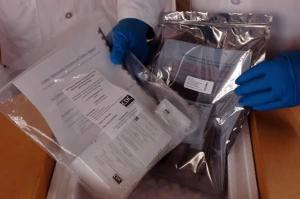
The Nintendo Wii may help treat symptoms of Parkinson's disease, including depression, a Medical College of Georgia researcher says.Parkinson’s disease is a degenerative disease that impairs motor skills. Dr. Herz theorized that the popular computer game console, which simulates various sports and activities, could improve coordination, reflexes and other movement-related skills, but he found additional benefits as well.
"The Wii allows patients to work in a virtual environment that's safe, fun and motivational," says Dr. Ben Herz, program director and assistant professor in the School of Allied Health Sciences Department of Occupational Therapy. "The games require visual perception, eye-hand coordination, figure-ground relationships and sequenced movement, so it's a huge treatment tool from an occupational therapy perspective."
In an eight-week pilot study, 20 Parkinson’s patients spent an hour playing the Wii three times a week for four weeks. The patients, all in a stage of the disease in which both body sides are affected but with no significant gait disturbance yet, played two games each of tennis and bowling and one game of boxing—games entailing exercise, bilateral movement, balance and fast pace.
"By the middle of the study, we actually had a number of people who could [defeat] their opponent out in the first round, which amazed us," says Dr. Herz, who presented his preliminary findings at the fifth annual Games for Health Conference today in Boston.
The victories weren't the biggest surprise, however. Participants showed significant improvements in rigidity, movement, fine motor skills and energy levels. Perhaps most impressively, most participants' depression levels decreased to zero.
An estimated 45 percent of Parkinson’s patients are reported to suffer from depression, though Dr. Herz suspects the actual figure is much higher.
Studies have shown that exercise and video games independently can increase the production of dopamine, a neurotransmitter deficient in Parkinson's patients. He suspects that's the case with the Wii’s exercise effect. Dopamine also helps improve voluntary, functional movements, which Parkinson’s patients "use or lose," Dr. Herz says.
Wii, which features simulated movements such as cracking an egg, swinging a tennis racket and throwing a bowling ball, responds to a player's movements rather than cues from a controller, so players can do full body movements and see their progress on a screen.
"I think we're going to be using virtual reality and games a lot more because it provides a controlled physical environment that allows patients to participate in the activities they need or want to do. A patient doesn't have to go to a bowling alley and worry about environmental problems or distractions," Dr. Herz says.
Dr. Herz's research was funded by a $45,000 grant from the National Parkinson's Foundation. Next he plans to test the Wii Fit balance board with Parkinson's patients and expand his studies to multiple sites.
"Game systems are the future of rehab," Dr. Herz says. "About 60 percent of the study participants decided to buy a Wii for themselves. That speaks volumes for how this made them feel."
INTERNAL MEDICINE The internal medicine blog , where you can have details on alternatice medicine , latest trends in medicine , new drugs in the market , school of medicine etc
Nintendo Wii May Enhance Parkinson's Treatment
Friday, June 12, 2009 at 9:34 PM Posted by Sajith
Red Wine Compound Resveratrol Demonstrates Significant Health Benefits
at 9:32 PM Posted by Sajith

The benefits of alcohol are all about moderation. Low to moderate drinking – especially of red wine – appears to reduce all causes of mortality, while too much drinking causes multiple organ damage. A mini-review of recent findings on red wine's polyphenols, particularly one called resveratrol, will be published in the September issue of Alcoholism: Clinical & Experimental Research; the review is also available at Early View.Reports on the benefits of red wine are almost two centuries old," said Lindsay Brown, associate professor in the School of Biomedical Sciences at The University of Queensland and corresponding author for the study. "The media developed the more recent story of the French paradox in the early 1990s. However, studies on the actions of resveratrol, one of the active non-alcoholic ingredients, were uncommon until research around 1997 showed prevention of cancers. This led to a dramatic interest in this compound."
Red wine contains a complex mixture of bioactive compounds, including flavonols, monomeric and polymeric flavan-3-ols, highly colored anthocyanins, as well as phenolic acids and the stilbene polyphenol, resveratrol. Brown said that some of these compounds, particularly resveratrol, appear to have health benefits.
"The breadth of benefits is remarkable – cancer prevention, protection of the heart and brain from damage, reducing age-related diseases such as inflammation, reversing diabetes and obesity, and many more," said Brown. "It has long been a question as to how such a simple compound could have these effects but now the puzzle is becoming clearer with the discovery of the pathways, especially the sirtuins, a family of enzymes that regulate the production of cellular components by the nucleus. 'Is resveratrol the only compound with these properties?' This would seem unlikely, with similar effects reported for other components of wine and for other natural products such as curcumin. However, we know much more about resveratrol relative to these other compounds."
Stephen Taylor, professor of pharmacology at the University of Queensland, agreed that resveratrol is the "compound du jour."
"I think that red wine has both some mystique and some historical symbolism in the west," said Taylor, "and of course, some various pleasures attached to its ingestion, all of which give it a psychological advantage edge, food-wise. Not many of us can or will eat a couple of cups of blueberries a day for years on end, but if we could do a population study for a decade or so on such a group, you might actually see similar results."
Key points of the review include:
* Resveratrol exhibits therapeutic potential for cancer chemoprevention as well as cardioprotection.
"It sounds contradictory that a single compound can benefit the heart by preventing damage to cells, yet prevent cancer by causing cell death, said Brown. "The most likely explanation for this, still to be rigorously proved in many organs, is that low concentrations activate survival mechanisms of cells while high concentrations turn on the in-built death signals in these cells."
* Resveratrol may aid in the prevention of age-related disorders, such as neurodegenerative diseases, inflammation, diabetes, and cardiovascular disease.
"The simplest explanation is that resveratrol turns on the cell's own survival pathways, preventing damage to individual cells," said Brown. "Further mechanisms help, including removing very reactive oxidants in the body and improving blood supply to cells."
* Low doses of resveratrol improve cell survival as a mechanism of cardio- and neuro-protection, while high doses increase cell death.
"The key difference is probably the result of activation of the sirtuins in the nucleus," said Brown. "Low activation reverses age-associated changes, while high activation increases the process of apoptosis or programmed cell death to remove cellular debris. Similar changes are seen with low-dose versus high-dose resveratrol: low-dose resveratrol produces cellular protection and reduces damage, while high-dose resveratrol prevents cancers."
In summary, noted Brown, current scientific research is starting to explain reports from the last 200 years that drinking red wine improves health. "It is a cliché that 'nature is a treasure trove of compounds,' but studies with resveratrol show that this is correct! We need to understand better the vast array of compounds that exist in nature, and determine their potential benefits to health."
"There is one particular point that deserves fleshing out," added Taylor. "Resveratrol is largely inactivated by the gut or liver before it reaches the blood stream, where it exerts its effects – whatever they may be – good, bad, or indifferent. Thus, most of the reseveratrol in imbibed red wine does not reach the circulation. Interestingly, absorption via the mucous membanes in the mouth can result in up to around 100 times the blood levels, if done slowly rather than simply gulping it down. Of course, we don't know if these things matter yet, but issues like this are real and generally ignored by all."
BPA Found In Many Plastics May Cause Heart Disease In Women
at 6:55 AM Posted by Sajith

New research by a team of scientists at the University of Cincinnati (UC) shows that bisphenol A (BPA) may be harmful for the heart, particularly in women.Results of several studies are being presented in Washington, D.C., at ENDO 09, the Endocrine Society's annual meeting, June 10-13.
A research team lead by Scott Belcher, PhD, Hong Sheng Wang, PhD, and Jo El Schultz, PhD, in the department of pharmacology and cell biophysics, found that exposure to BPA and/or estrogen causes abnormal activity in hearts of female rats and mice.
In addition, these researchers found that estrogen receptors are responsible for this affect in heart muscle cells.
"There is broad exposure to bisphenol A, despite recognition that BPA can have harmful effects," Belcher says. "We had reason to believe that harmful cardiovascular affects can be added to the list."
BPA, an environmental pollutant with estrogen activity, is used to make hard, clear plastic and is common in many food product containers. It has been linked to neurological defects, diabetes and breast and prostate cancer.
Using live cultures of cells isolated from rat or mouse hearts, researchers briefly exposed the cardiac cells to BPA and/or estrogen. Both compounds caused striking changes in the activity of cardiac muscle cells from females but not males. Additional studies revealed that these cellular changes in activity caused improperly controlled beating in the female heart.
"Low doses of BPA markedly increased the frequency of arrhythmic events," Belcher says. "The effect of BPA on these cardiac arrhythmias was amplified when exposed to estradiol, the major estrogen hormone in humans."
The mechanism underlying this harmful effect was investigated using cellular imaging techniques.
"BPA and/or estrogen rapidly stimulated contraction by altering control of the concentrations of free calcium inside the heart cell but only in heart muscle cells from females, showing that these effects were sex-specific," Belcher says. "BPA's presence increased the frequency of calcium 'sparks' from the sarcoplasmic reticulum—the part of the cardiac muscle that stores and releases calcium ions—indicating spontaneous release or 'leak' that's likely causing the heart arrhythmias and may have other harmful actions, especially following heart attack."
Belcher and colleagues also investigated the nature of the mechanisms that mediated the responses of the cardiac muscle cells to estrogen and BPA.
"Pharmacological studies using selective estrogen receptor drugs and animal models lacking estrogen receptors were used to investigate the role of each estrogen receptor in mediating the rapid sex-specific function effects of E2 and BPA in cells," he says. "Our findings suggest that estrogen has opposing actions in cardiac cells.
"In female cardiac muscle cells, the blocking or genetic removal of estrogen receptor beta completely blocked the contractile effects of BPA and estrogen, while in males, blockade of the effects of estrogen receptor alpha caused the male heart to become more 'female-like' and become responsive to estrogen and BPA.
"These studies have identified new and important potential cardiac risks associated with BPA exposure that may be especially important for women's heart health," he says.
This study was funded by grants from the National Institutes of Health and the UC Center for Environmental Genetics.
WHO Declares Pandemic In Response To Ongoing Global Spread Of Novel Influenza A (H1N1) Virus
at 6:51 AM Posted by Sajith

On June 11, 2009, the World Health Organization (WHO) raised the worldwide pandemic alert level to Phase 6 in response to the ongoing global spread of the novel influenza A (H1N1) virus, which causes swine flu. A Phase 6 designation indicates that a global pandemic is underway.More than 70 countries are now reporting cases of human infection with novel H1N1 flu. This number has been increasing over the past few weeks, but many of the cases reportedly had links to travel or were localized outbreaks without community spread. The WHO designation of a pandemic alert Phase 6 reflects the fact that there are now ongoing community level outbreaks in multiple parts of world.
WHO’s decision to raise the pandemic alert level to Phase 6 is a reflection of the spread of the virus, not the severity of illness caused by the virus. It’s uncertain at this time how serious or severe this novel H1N1 pandemic will be in terms of how many people infected will develop serious complications or die from novel H1N1 infection. Experience with this virus so far is limited and influenza is unpredictable. However, because novel H1N1 is a new virus, many people may have little or no immunity against it, and illness may be more severe and widespread as a result. In addition, currently there is no vaccine to protect against novel H1N1 virus.
In the United States, most people who have become ill with the newly declared pandemic virus have recovered without requiring medical treatment, however, CDC anticipates that there will be more cases, more hospitalizations and more deaths associated with this pandemic in the coming days and weeks. In addition, this virus could cause significant illness with associated hospitalizations and deaths in the fall and winter during the U.S. influenza season.
Background
Novel influenza A (H1N1) is a new flu virus of swine origin that first caused illness in Mexico and the United States in March and April, 2009. It’s thought that novel influenza A (H1N1) flu spreads in the same way that regular seasonal influenza viruses spread, mainly through the coughs and sneezes of people who are sick with the virus, but it may also be spread by touching infected objects and then touching your nose or mouth. Novel H1N1 infection has been reported to cause a wide range of flu-like symptoms, including fever, cough, sore throat, body aches, headache, chills and fatigue. In addition, many people also have reported nausea, vomiting and/or diarrhea.
The first novel H1N1 patient in the United States was confirmed by laboratory testing at CDC on April 15, 2009. The second patient was confirmed on April 17, 2009. It was quickly determined that the virus was spreading from person-to-person. On April 22, CDC activated its Emergency Operations Center to better coordinate the public health response. On April 26, 2009, the United States Government declared a public health emergency and has been actively and aggressively implementing the nation’s pandemic response plan.
Since the outbreak was first detected, an increasing number of U.S. states have reported cases of novel H1N1 influenza with associated hospitalizations and deaths. By June 3, 2009, all 50 states in the United States and the District of Columbia and Puerto Rico were reporting cases of novel H1N1 infection. While nationwide U.S. influenza surveillance systems indicate that overall influenza activity is decreasing in the country at this time, novel H1N1 outbreaks are ongoing in parts of the U.S., in some cases with intense activity.
CDC is continuing to watch the situation carefully, to support the public health response and to gather information about this virus and its characteristics. The Southern Hemisphere is just beginning its influenza season and the experience there may provide valuable clues about what may occur in the Northern Hemisphere this fall and winter.
Search
Labels
- Alzheimer's (10)
- Antibiotics (7)
- Anxiety (1)
- articles (2)
- Bacteria (1)
- behavioral abnormality (1)
- Bio technology (1)
- Brain (8)
- breast cancer (6)
- Cancer (40)
- cancer treatment (7)
- chemotherapy (6)
- Chlamydia (1)
- Cytology (3)
- Death (1)
- Diabetes Mellitus (7)
- Diet (17)
- DNA (1)
- Doctors (1)
- epilepsy (2)
- Fossil (1)
- fruits (1)
- genes (6)
- Genetics (13)
- Geriatrics (1)
- Health (12)
- Heart diseases (9)
- Herbal Medicine (2)
- HIV and AIDS (7)
- influenza (1)
- Inventions (1)
- IVF (1)
- latest findings (1)
- Life style (2)
- Lung Cancer (1)
- Lung Disease (9)
- Microbiology (1)
- Multiple Sclerosis (1)
- Nanotechnology (3)
- Neonatology (1)
- neurology (1)
- News (18)
- Parkinsonism (2)
- Prevention (1)
- Primates (1)
- Prostate cancer (1)
- Prosthetics (1)
- seizure (2)
- Skin (1)
- STD (2)
- Stem cells (9)
- Stroke (1)
- Surgery (2)
- Swine flu (11)
- Virus (1)
- weight loss (1)
Search The Web
Blog Archive
Minyx v2.0 template es un theme creado por Spiga. | Minyx Blogger Template distributed by eBlog Templates
